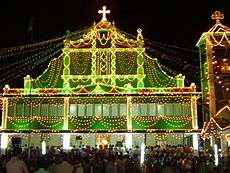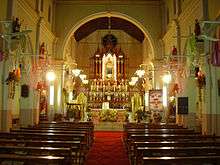Our Lady of the Miracles Cathedral, Kallianpur
| Our Lady of the Miracles Cathedral | |
|---|---|
|
Igreja Nossa Senhora do Milagres Church of Our Lady of Miracles | |
 Milagres Cathedral illuminated at night | |
 Our Lady of the Miracles Cathedral | |
| 13°23′45″N 74°44′10″E / 13.395729°N 74.736224°ECoordinates: 13°23′45″N 74°44′10″E / 13.395729°N 74.736224°E | |
| Location | Kallianpur, Udupi district, Karnataka |
| Country | India |
| Denomination | Roman Catholic (Latin rite) |
| Website |
www |
| History | |
| Founded | 1678 |
| Architecture | |
| Status | Cathedral |
| Functional status | active |
| Designated | 2012 |
| Specifications | |
| Bells | 3 |
| Administration | |
| Parish | Kallianpur |
| Deanery | Kallianpur |
| Diocese | Roman Catholic Diocese of Udupi |
| Province | Roman Catholic Archdiocese of Bangalore |
| Clergy | |
| Bishop(s) | Most.Rev.Dr.Gerald Isaac Lobo |
| Rector | Very.Rev.Fr.Stany B Lobo |
| Vicar(s) | Very.Rev.Fr.Stany B Lobo |
| Priest(s) | Rev.Fr.Ferdinand Gonsalves |
| Assistant priest(s) | Rev.Fr.Mahesh D'Souza |
| Chaplain(s) | Rev.Dr.Canute Barboza ( Ozanam Ashram ) |
The Our Lady of the Miracles Cathedral[1] (Portuguese: Igreja Nossa Senhora do Milagres, also Church of Our Lady of Miracles) is a Roman Catholic Cathedral situated at Kallianpur in Udupi district, Karnataka.
The Milagres Church was originally established in 1680, as a result of a treaty between Rani Chennamma of Bednur and the Portuguese, and rebuilt in present form in 1881. The Church was upgraded to Cathedral status in 2012, giving a desirable fillip to the Konkani Catholic people.[2]
History
During the period of the Keladi Nayakas, Kallianpur emerged as an important Christian settlement in South Canara.[3] The church was constructed by the Portuguese in 1678, and dedicated to Our Lady of Miracles.[4] The land on which the church was built was gifted to the local Christians by Rani Chennammaji and Somashekara Nayaka I.[3]
The miraculous statue of Milagres Kallianpur extracted from writings of Mr. Charles E. G Lewis Kallianpur dated 1982. The statue of Our Lady of Milagres, Kallianpur is popularly claimed to be miraculous in and around the surrounding region. when the English lost war in 1784, the enemies of Christians gave secret orders to his commanders to seize all Christians in Canara and take them captive to Srirangapatana. They carried out the secret orders and entered every Christian settlement simultaneously throughout Kanara. Complete families with children in arms were brutally hounded, herded and marched captive across the Western Ghats. Only a few people managed to stay in hiding. The churches were destroyed and also were the churches at Barkur and Patre. The priests had gone in to hiding or had been captured and deported to Goa. It was this time the enemy soldiers played havoc destroying everything and they attempted to remove the Statue of our Lady on the High Altar for desecration. They found it was not possible to remove it or lift it with hands. She would not move. She would not yield. They used force with tools but without success. But at that very moment, a large swarm of bees (wasps) suddenly came upon them unknown from where and attacked and stung them. They ran helter shelter, the venomous bees followed them. They rode down as far as the Suvarna River; the wasps still pursued them until the soldiers dived and tried to hide in the water. This occurrence was known far and wide in the area and produced awe and reverence among the people including Non-Christians to Our Lady their ‘MILAGRI AMMA’. At that time one of the parishioners who was in hiding Mr. Menino Francies Luis of Nadu Kudru, Tonse, secretly carried away the Miraculous Statue from the devastated church after much praying and promising that he would bring and place her with due honour when the ordeal would be over. He carried her to his ancient home in Thonse and venerated it secretly with his family and the rest of the Christians in night vigils with rosary and reading of the Christian Purana of Fr. Thomas Stevens S.J. The statue had sometimes to be hidden in other houses and specially one Hindu house whose descendants were honoured every year with a candle on the occasion of the Annual parish feast. When things brightened up with the enemies death and Priests came after return of Christians from captivity, the Miraculous Statue was brought back with great honour and Jubilation amidst rejoicing through the river and road in a colourful two mile long route boat procession and re-enthroned in the church on the high Altar(currently installed in the Shrine ). In memory and honour of this event a yearly boat procession of our Lady on a gaily and artistically decorated throne ( Cherell) with much solemnity grandeur and pomp was celebrated at first from Nadu Kudru to the church on the eve of the parish feast from the ancient house of Mr. Menino Francis Luis; but in the latter years the procession was from its neighbouring Honappa Kudru from a house of his direct descendants for over a century. In the final years the procession commenced from Our Lady’s Island Property of Barikudru due to uncertainty of tides to bring it from Tonse. Glowing accounts of the grandeur of those annual evening festive processions and the devotion generated when all communities joined the celebrations with decorative lamps, arches and buntings on its route were narrated with pride and nostalgia for those days by men of the generation that has now passed. It would be interesting to know another tradition. The statue used for those processions is the one now used for Cherell in the church for processions on the feast days. This statue was found on the Malpe shore and was delivered by the fisher men to the church. It is believed to be the statue placed by Vasco da Gama on the Thonse Par Islands when he landed there and which were named by him as St. Mary's Islands.
In 2012, it was appointed as the Cathedral church of the newly formed diocese, Roman Catholic Diocese of Udupi.,[5] which was inaugurated on October 15, 2012, at the church.[6][7]
Gallery
 Milagres Cathedral interior
Milagres Cathedral interior_Kallianpur_Udupi_during_1960s.jpg) Milagres Church, (now Cathedral) Kallianpur Udupi during 1960s
Milagres Church, (now Cathedral) Kallianpur Udupi during 1960s Our Lady of miracles Kallianpur
Our Lady of miracles Kallianpur Our Lady of Milagres in the shrine
Our Lady of Milagres in the shrine Milagres Church Pulpit during 1960s
Milagres Church Pulpit during 1960s
- ↑ "Cathedral of Our Lady of the Miracles, Udupi, Karnataka, India". www.gcatholic.org. Retrieved 2016-11-19.
- ↑ Shet, I J S (30 December 2014). "Kallianpur gets a cathedral" (Bangalore). Deccan Herald. Retrieved 16 January 2015.
- 1 2 Pinto 1999, p. 157
- ↑ Farias 1999, p. 222
- ↑ Erection Of The Diocese Of Udupi (India) And Appoints First Bishop catholica.va.
- ↑ "History in the Making: Erection Ceremony of Udupi Diocese Gets Under Way". Daiji World. October 15, 2012.
- ↑ "Udupi becomes 9th Diocese under Bangalore Archdiocese". Indian Express. 16 October 2012.
[1]
References
- Farias, Kranti K. (1999). "The Christian impact in South Kanara". Mumbai: Church History Association of India..
- Pinto, Pius Fidelis (1999). "History of Christians in coastal Karnataka, 1500–1763 A.D.". Mangalore: Samanvaya Prakashan..
External links
| Wikimedia Commons has media related to Milagres Church (Kallianpur). |
- ↑ Painting of Milagres Church during 60s is by Owen Rodrigues a native to Kallianpur